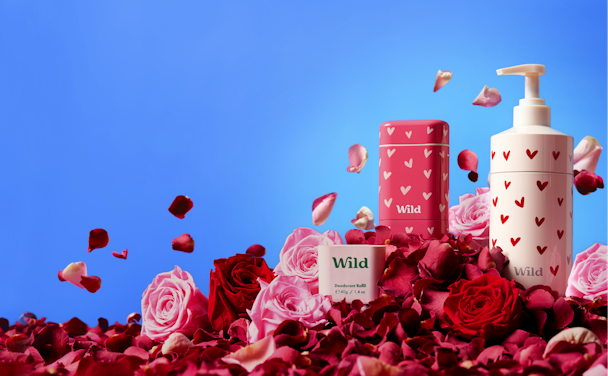How to build a sustainable brand: lessons from Wild Deodorant’s marketing boss
Last month, the deodorant brand launched its first-ever TV ad, sharing its plastic-free mission. As marketing director Harry Symes-Thompson tells The Drum, however, communicating sustainability hasn’t always been his top marketing priority.

Wild Deodorant's limited edition valentines day packaging / Wild
Wild was one of the first refillable deodorant brands to launch in the UK, conceived as part of a bigger mission to end single-use plastic in the bathroom. The company’s director of marketing, Harry Symes-Thompson, says, however, that it must be “careful with its mission” when marketing to consumers. “We are aware that customers need to have a product that works and that it fits into their lifestyle before they think about sustainability,” he explains.
When Wild launched, everything was about product functionality, with Symes-Thompson admitting that the product did a lot of the marketing in the beginning. “We do need to make sure that we’re getting the balance right and are focused on the product and the aesthetic and that the efficacy is there to retain those customers.”
Advertisement
Four years on, though, the startup has sold 8m deodorants and has evolved from a DTC business to being stocked in leading retailers, such as Tesco, Boots and Sainsbury’s. Now, Symes-Thompson says Wild can focus on landing its ethos and sustainable mission.
“People are a lot more familiar with Wild, so now it’s about thinking how to make customers feel like they’re also contributing to our ethos and the planet.”
Wild’s journey so far
Launched in 2020, Wild benefitted from lockdown habits, with people stuck at home looking for DTC options for buying bathroom products. People were also more concerned about their health and looking for better products for their skin.
Initially, Wild was marketed entirely through paid social, referral codes in packaging and some organic social. “In those early days, you just have to be sure that your marketing money is going to go as far as possible. Our cost per acquisition was just insanely low.”
Advertisement
As word spread, Wild signed affiliate partnerships by working with bloggers and the rewards sites of Vodafone and Three Mobile. After paid social and affiliate partnerships started to “run out of steam,” Symes-Thompson jumped into influencer marketing, which he credits as a “massive” part of Wild’s growth. “We found that Wild cut through on social and people wanted to share it; it was new and bright and colorful and sustainable and people love sharing products like that on social.”
After a couple of years of high growth, Wild got a second round of VC funding, which unlocked longer-term brand marketing budgets. After landing the product messaging, the team had to figure out what Wild’s brand identity was and what it stood for.
“Wild is quite determined to be the bathroom brand that is synonymous with removing all single-use plastic,” Symes-Thompson says of the mission. This has led it to launch other products, including solid shampoos, soaps and refillable body wash. On the identity side, Symes-Thompson says: “We always wanted to live up to the brand name of Wild, to do something a little bit out there and be quirky and loud.”
Wild’s first major brand campaign, showing a female masturbation scene, was banned by the Advertising Standards Authority for being inappropriate for kids.
The VC money also helped Wild launch into retail and is now available in over 10,000 stores, from Sainsbury’s to Boots, Waitrose and Tesco. Now in retail, Symes-Thompson had to move Wild up the marketing funnel, so while digital marketing is still an integral channel, Wild ads are now on TV and in podcasts. TikTok Shop is also gaining importance in Symes-Thompson’s marketing mix, with around 5% of Wild’s revenue coming through live shopping.
Suggested newsletters for you
The sustainable deodorant market has increased since Wild launched in 2020 and the brand now competes with the likes of Fussy, Salt of the Earth and even Dove, which launched a refillable option in September. But Symes-Thompson isn’t worried about the competition and says the growth of the category is more important.
“We are market leaders, especially in the UK, and a lot of that came to first mover advantage and how quickly we were able to keep up with the growth and rescale our marketing budgets.”
Symes-Thompson’s top tips for marketing a sustainable brand:
-
Do one thing and do it well: “A lot of brands launch hundreds of products, a million things at once, and it dampens their messaging and mission. Customers understand who we are and why they buy Wild and that has been so important and helped us focus our sustainability mission.”
-
Back up your claims: “To have a sustainable sustainability angle, you do need to back it up with claims and show your consumers how you are making an effort and what that means to them, making sure that regular customers understand and know about the impact that they’re making.”
-
Take risks: “It might sound a bit cliche, but Wild are big believers in taking bold, big risks to grow the brand like crazy, so YouTube videos or silly stunts. You might think the brand is going to become damaged as a result, but they’re the things that you need to take calculated risks on and they’re going set you apart from the crowd.”

